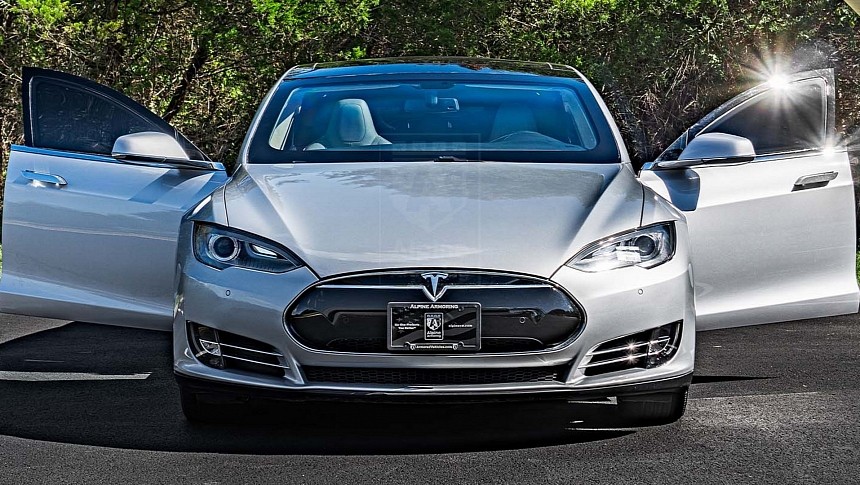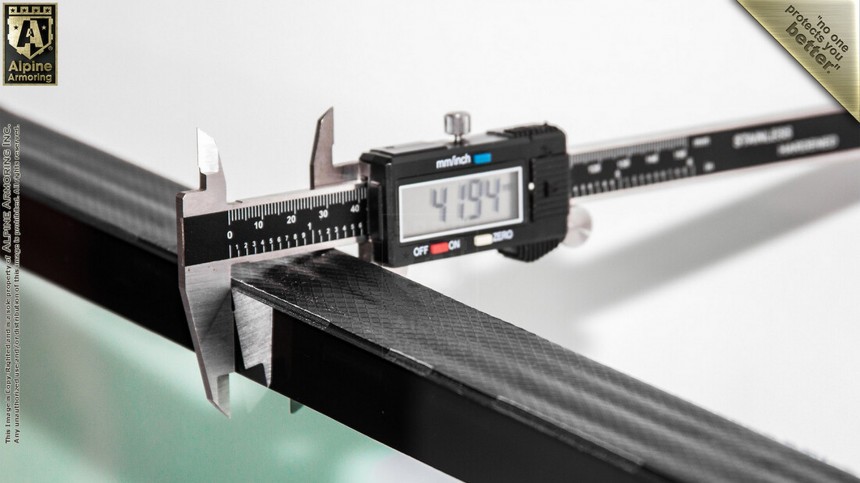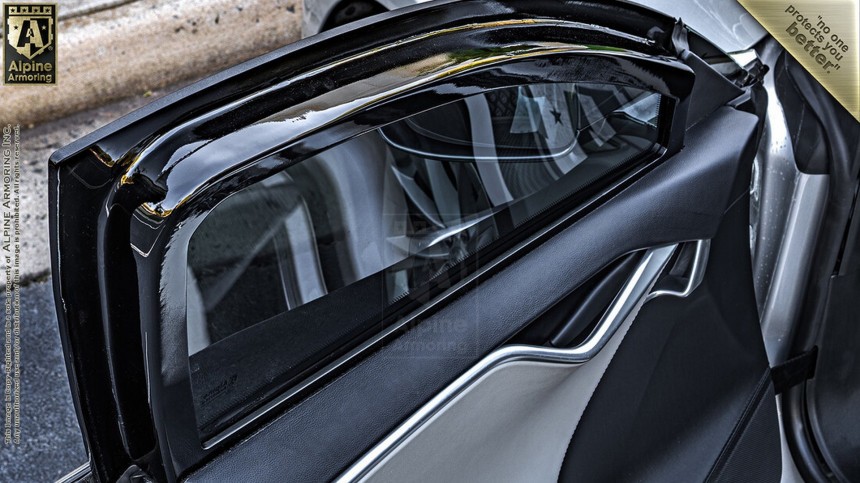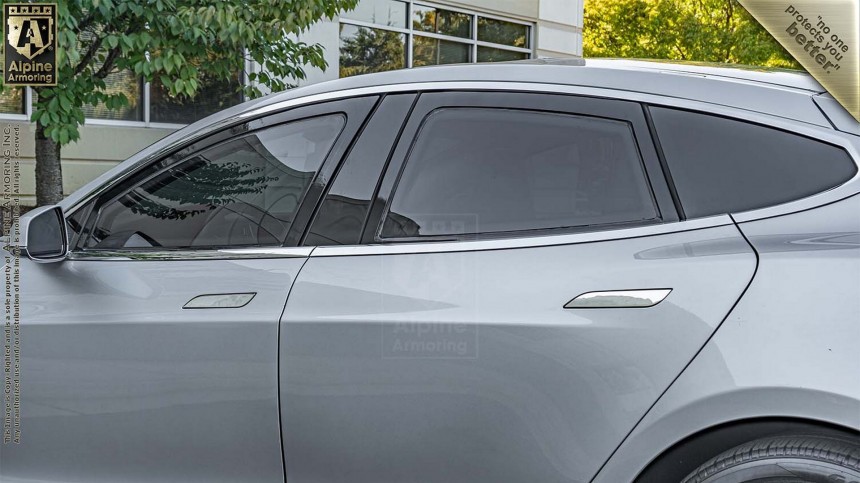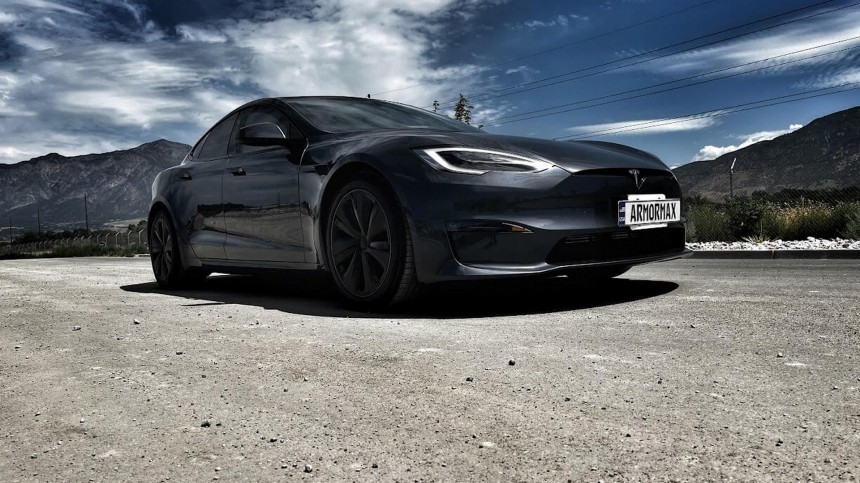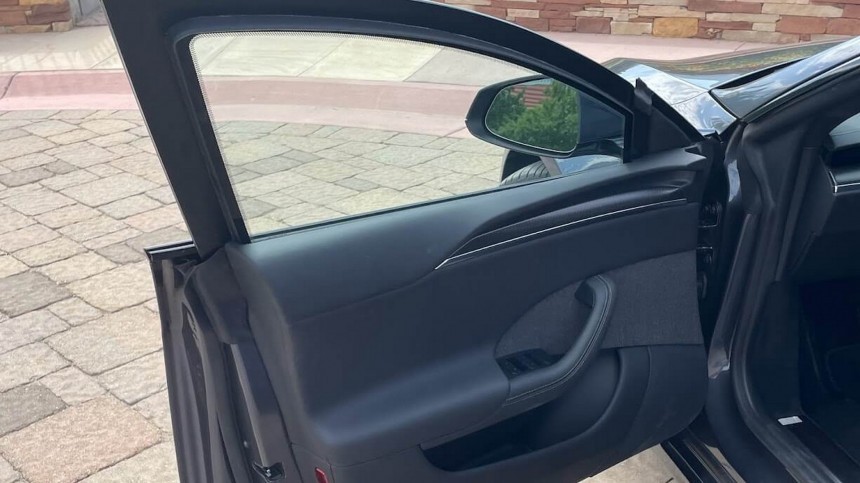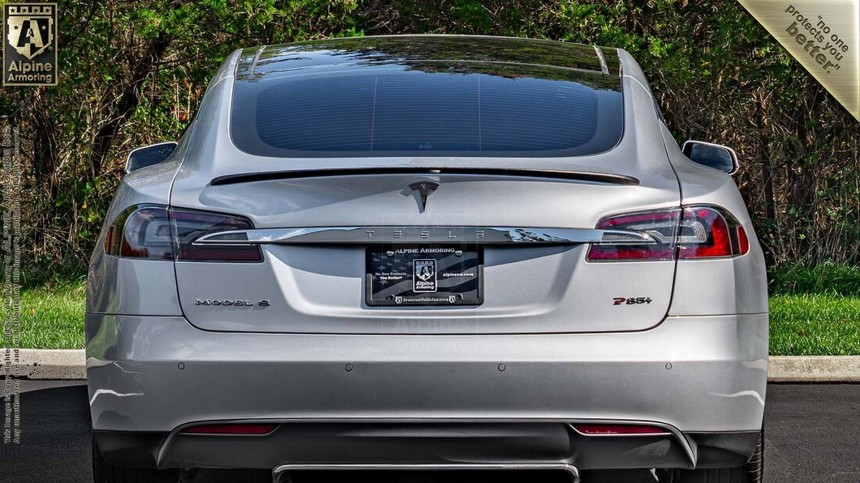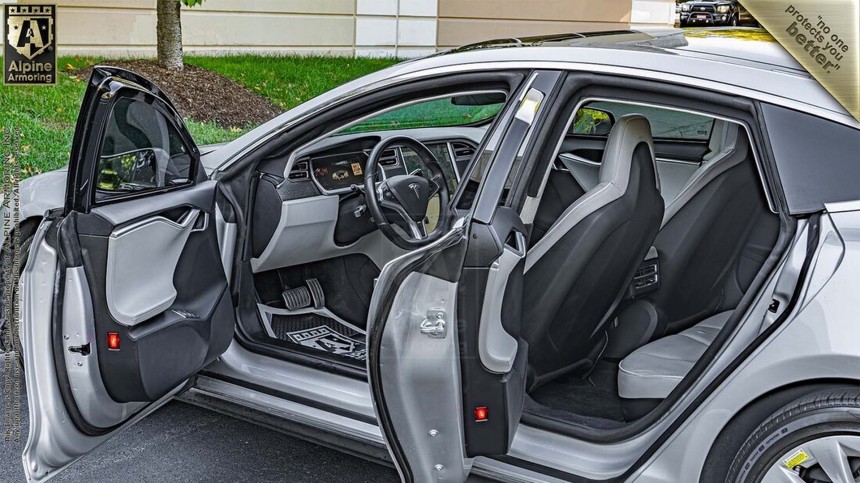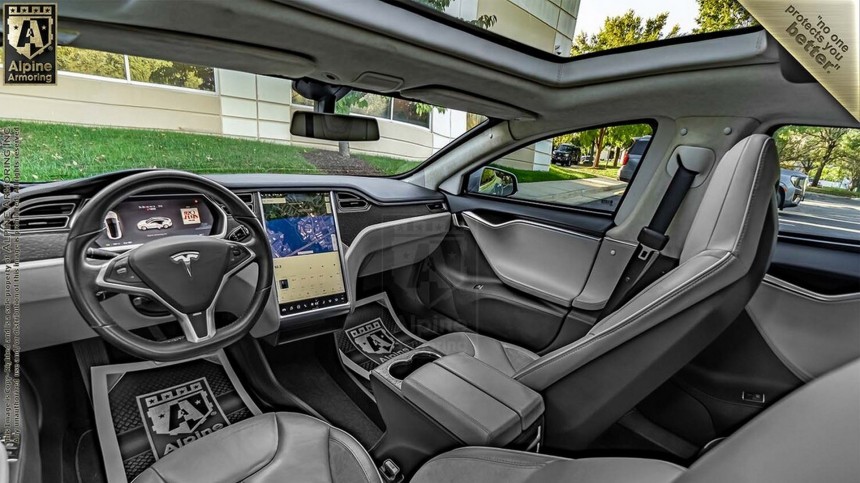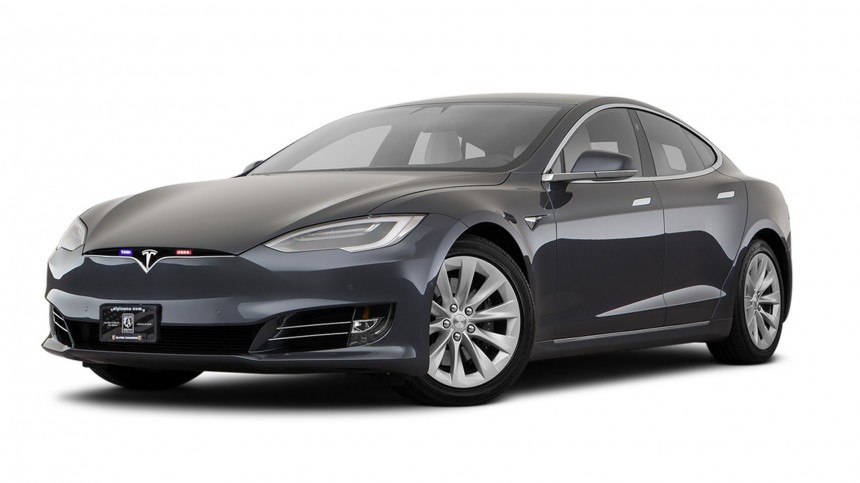Electric vehicles are mostly gaining terrain in developed countries, where crime rates are not as much of a concern as they are in developing ones. When battery-electric vehicles (BEVs) start reaching places where armored cars are common or even necessary, people will also want to armor them. What about Teslas, with their frameless doors? I contacted armoring companies that are already doing that to understand the implications.
As I already mentioned, my main interest was understanding how these companies dealt with the fact that all Teslas, apart from the Model X, have frameless doors. For these vehicles to be armored, the companies have to create the frames, as Cameron Khoroushi told me. The director of design and engineering at Alpine Armoring said his company started working with Teslas in late 2013. For him, adding frames to doors that did not have them "is not challenging but merely a different implementation to the design process."
"We design custom ballistic opaque armor for the outer channels of the glass to fit into the OEM channel, and the glass sits snug inside this channel as opposed to the armored glass being frameless, which is not done as that would introduce vulnerabilities and issues closing the door."
That's a modest way to frame (pun intended) building an entirely new part of a car. Mark Burton has a different point of view. According to ArmorMax's founder and CEO, that can be a complicated element of armoring a Tesla.
"It is very challenging, and our team has a lot of experience working on similar vehicles without a door frame. Several structural adjustments underneath need to be added to support the thicker glass and still hold it in the door channel."
Although it does not make much sense to open the windows in an armored vehicle, ArmorMax and Alpine Armoring offer that possibility to their clients. ArmorMax uses "special aftermarket motors that are able to lift the glass up and down." According to its CEO, "the range of operability is determined by the spacing inside the door and the thickness of glass." Khoroushi was more specific about how that reflects in the American BEV maker's products.
"Our armored Teslas have optional armored power windows. We had to develop completely custom window motors for the Tesla Model S due to the design complications inside the door. The power windows can go down roughly 6 inches (15.2 centimeters)."
In other words – and for obvious reasons – you will never see an armored Tesla with frameless doors. That will already make these unusual Model S, Model 3, and Model Y units stand out from regular ones, which is not what armored car owners usually want them to be: the more discreet and similar to standard cars they are, the better. But this is hardly the only technical challenge Teslas offer with armoring. Among other difficulties, there's the aluminum body on the Model S and the Model X. For the Burton, aluminum bodies are indeed a bit more troublesome to armor, but not that much.
"It is more difficult to install armor on aluminum bodies but more so to the fact that you have to use different methods and tools."
The Alpine Armoring director elaborated on these challenges.
"More time and engineering are required for aluminum body vehicles due to different processes in adhering the opaque armor to the vehicle. Structural ribbing and mounting points require adjusted designs to prevent panels from buckling under inappropriate loads."
Tesla vehicles have another complication: their cameras. Even replacing the windshield in a car that relies on Tesla Vision for things as basic as parking maneuvers can be pretty sensitive. How do you armor the B-pillars with the cameras Teslas have? The ArmorMax CEO just said that "anytime you are dissembling a vehicle, there are always going to be technical difficulties." Khoroushi was more specific.
"In many ways, Teslas are actually easier to armor, as the center of gravity is lower and there is no engine or radiator to protect. Alpine uses a specially designed transparent armor process to keep the cameras working that we developed on the new generation Mercedes-AMG G 63 in early 2019: that eliminates any chance of visual refraction issues that the cameras may anticipate."
The low center of gravity in Teslas and all BEVs is due to the massive battery pack they have to carry. If they are easier to armor, they also carry an enormous and vulnerable component. In March 2014, Tesla had to reinforce the battery pack shield when some Model S units caught fire after running over road debris. Some cases still pop up every once in a while, with the most recent one that I have seen happening in November 2022 in Pennsylvania. In other words, damage to it may cause thermal runaway events.
Now imagine a rifle bullet perforating the component. Causing the vehicle to stop may be the smallest issue such a situation could present. Despite these risks, Burton said that battery packs "are pretty well packaged and protected." "On the armoring side, we put our fragmentation blankets on top of the battery to protect the passengers inside the vehicle in the event of an IED (improvised explosive device) blast."
Khoroushi stated that "explosive protection when it comes to EVs is still in a grey area with the armoring industry" – and you'll understand why a bit further.
"Currently, Alpine Armoring is undergoing R&D for explosive testing on EVs to see how the energy and blast dissipation affects the batteries of the vehicle."
As competent as the armory industry has to be, it cannot prevent increasing the mass of armored vehicles. BEVs already are pretty heavy due to their battery packs, and making them even heftier will not help their ranges. Apart from that, there are several different armoring levels. Choosing a light and more affordable one may imply you are not guarding the car against the kind of weapon that criminals are using.
Brazil is one of the world champions in armored vehicle sales and has a notorious story to illustrate that. In 2004, a Rio de Janeiro city councilman died when four heavily armed men shot his Honda Civic. João Monteiro de Castro dos Santos told his driver not to stop when the criminals ordered them to do so because the car was armored. The issue was that the murderers had assault rifles, something the armoring level of the councilman's car was not prepared to handle. He would have needed a B6+/A9 level to escape.
Burton gave me some examples of armoring levels his company offers to Tesla cars and how much weight they usually add to these vehicles. "B4 is handgun protection," and it makes vehicles "approximately 195 kilograms (430 pounds)" heavier. B5 increases mass by "around 340 kg (780 lb)," and B6+ – which offers high-powered rifle protection – should make a Tesla "approximately 560 kg (1,200 lb)" bulkier.
Alpine Armor also works with several armoring levels, but Khoroushi told me the company started applying the A9/B6+ level to Tesla BEVs in 2020. He also shared how much mass it adds to a Model S.
"A copious amount of lightweight composite material was used to keep the overall weight of the vehicle down, especially in areas that are flat, such as the inside of the doors and the back wall behind the seats. We added roughly 1,350 lb (612.4 kg) to the vehicle."
Predictably, this additional load has an impact on range. The ArmorMax CEO said that the B4 package makes a BEV run "around 4% to 8%" less, which is "similar to (having) 2 to 3 adults in the vehicle." The A9/B6+ armoring level has a much higher effect. According to the Alpine Armoring director, the Teslas his company prepares lose "roughly 20%" of the range. Anyone considering owning an armored BEV should focus on buying the option with the most range: Khoroushi advised them to purchase "any AWD or high-performance Teslas" because "these vehicles handle the weight of the armor better." And even they may not be enough to solve the range issue.
Take the Model S Long Range, with its theoretical capacity to run 405 miles on a single full charge. Edmunds made tests with Tesla vehicles in the past, and most of them failed to meet their EPA numbers. Anyway, let's consider that 405 miles were attainable. If Alpine Armoring takes care of this hypothetical Model S with an A9 armoring level, 20% will represent a loss of a bit more than 80 miles. On top of that, Tesla advises customers not to fully charge its products with ternary cells, only those with LFP batteries. That means the car will only have 80% (324 mi) to 90% (364.5 mi) of its charge capacity.
Combustion-engined vehicles also lose range with armor, but it only takes them a few minutes at fuel stations to solve that. Electric cars will have to stop more often at charging stations, where most of them hardly lose less than 30 minutes. When safety is critical, stopping at charging stations may increase the vulnerability of the BEV's occupants. On the other hand, electric cars can be recharged at home. If owners are sure they will never need to stop anywhere else but home for a charge, an armored BEV may be a good choice – but who can be certain about that? What if you suddenly need more energy to go somewhere that was not in the plans? An electric car will inevitably demand more time for that unless it has a swappable battery pack.
Things get even more complicated if you buy a Model 3 RWD and decide to give it an A9/B6+ armor level. With a 272-mile EPA range, it should lose slightly more than 54 miles. That restricts the BEV's ability to move around to a bit less than 218 miles. The cost to armor a vehicle will probably prevent that from happening with entry-level, low-range electric cars.
Burton told me that ArmorMax's "starter features on any vehicle are usually around $42,000 to $48,000." However, most of his customers "spend around $75,000 on a presidential package." With Alpine Armoring, the prices are much higher. Khoroushi said that the "minimum and maximum packages range from $85,000 to $350,000, depending on the base vehicle and armoring options." Who would pay more money for shielding a car than they paid to purchase it in the first place? For the investment to make sense, it has to be on expensive automobiles.
Taking all that into consideration, an armored Tesla is technically possible. However, we have to remember that an armored car is a safety tool. Tesla was sued for a design flaw with its motorized door handles. Its emergency door releases are difficult to reach. What will happen if the battery pack catches fire due to rifle shots or a bomb in a vehicle whose glasses can resist such shots? Tesla suspension components have notorious problems, although both armoring companies said they could handle the extra weight. What if they can't?
Above all, the battery pack may be the Achilles' heel of an armored BEV. Would offensive driving – used to evade hijacking ambushes and other dangerous traps – be possible in a BEV? What if you manage to escape and need more energy to keep running as fast as possible?
There are so many things that could go wrong with an armored BEV that people who actually need to protect themselves from gun violence should carefully consider all of them. It indeed is nice to be carbon neutral or close to it, but it may be the least of your concerns when safety is at stake. Strategically speaking, an ICE armored car may offer better chances of preventing and escaping an attack.
"We design custom ballistic opaque armor for the outer channels of the glass to fit into the OEM channel, and the glass sits snug inside this channel as opposed to the armored glass being frameless, which is not done as that would introduce vulnerabilities and issues closing the door."
"It is very challenging, and our team has a lot of experience working on similar vehicles without a door frame. Several structural adjustments underneath need to be added to support the thicker glass and still hold it in the door channel."
Although it does not make much sense to open the windows in an armored vehicle, ArmorMax and Alpine Armoring offer that possibility to their clients. ArmorMax uses "special aftermarket motors that are able to lift the glass up and down." According to its CEO, "the range of operability is determined by the spacing inside the door and the thickness of glass." Khoroushi was more specific about how that reflects in the American BEV maker's products.
"Our armored Teslas have optional armored power windows. We had to develop completely custom window motors for the Tesla Model S due to the design complications inside the door. The power windows can go down roughly 6 inches (15.2 centimeters)."
"It is more difficult to install armor on aluminum bodies but more so to the fact that you have to use different methods and tools."
The Alpine Armoring director elaborated on these challenges.
"More time and engineering are required for aluminum body vehicles due to different processes in adhering the opaque armor to the vehicle. Structural ribbing and mounting points require adjusted designs to prevent panels from buckling under inappropriate loads."
"In many ways, Teslas are actually easier to armor, as the center of gravity is lower and there is no engine or radiator to protect. Alpine uses a specially designed transparent armor process to keep the cameras working that we developed on the new generation Mercedes-AMG G 63 in early 2019: that eliminates any chance of visual refraction issues that the cameras may anticipate."
The low center of gravity in Teslas and all BEVs is due to the massive battery pack they have to carry. If they are easier to armor, they also carry an enormous and vulnerable component. In March 2014, Tesla had to reinforce the battery pack shield when some Model S units caught fire after running over road debris. Some cases still pop up every once in a while, with the most recent one that I have seen happening in November 2022 in Pennsylvania. In other words, damage to it may cause thermal runaway events.
Now imagine a rifle bullet perforating the component. Causing the vehicle to stop may be the smallest issue such a situation could present. Despite these risks, Burton said that battery packs "are pretty well packaged and protected." "On the armoring side, we put our fragmentation blankets on top of the battery to protect the passengers inside the vehicle in the event of an IED (improvised explosive device) blast."
"Currently, Alpine Armoring is undergoing R&D for explosive testing on EVs to see how the energy and blast dissipation affects the batteries of the vehicle."
As competent as the armory industry has to be, it cannot prevent increasing the mass of armored vehicles. BEVs already are pretty heavy due to their battery packs, and making them even heftier will not help their ranges. Apart from that, there are several different armoring levels. Choosing a light and more affordable one may imply you are not guarding the car against the kind of weapon that criminals are using.
Brazil is one of the world champions in armored vehicle sales and has a notorious story to illustrate that. In 2004, a Rio de Janeiro city councilman died when four heavily armed men shot his Honda Civic. João Monteiro de Castro dos Santos told his driver not to stop when the criminals ordered them to do so because the car was armored. The issue was that the murderers had assault rifles, something the armoring level of the councilman's car was not prepared to handle. He would have needed a B6+/A9 level to escape.
Alpine Armor also works with several armoring levels, but Khoroushi told me the company started applying the A9/B6+ level to Tesla BEVs in 2020. He also shared how much mass it adds to a Model S.
"A copious amount of lightweight composite material was used to keep the overall weight of the vehicle down, especially in areas that are flat, such as the inside of the doors and the back wall behind the seats. We added roughly 1,350 lb (612.4 kg) to the vehicle."
Take the Model S Long Range, with its theoretical capacity to run 405 miles on a single full charge. Edmunds made tests with Tesla vehicles in the past, and most of them failed to meet their EPA numbers. Anyway, let's consider that 405 miles were attainable. If Alpine Armoring takes care of this hypothetical Model S with an A9 armoring level, 20% will represent a loss of a bit more than 80 miles. On top of that, Tesla advises customers not to fully charge its products with ternary cells, only those with LFP batteries. That means the car will only have 80% (324 mi) to 90% (364.5 mi) of its charge capacity.
Things get even more complicated if you buy a Model 3 RWD and decide to give it an A9/B6+ armor level. With a 272-mile EPA range, it should lose slightly more than 54 miles. That restricts the BEV's ability to move around to a bit less than 218 miles. The cost to armor a vehicle will probably prevent that from happening with entry-level, low-range electric cars.
Taking all that into consideration, an armored Tesla is technically possible. However, we have to remember that an armored car is a safety tool. Tesla was sued for a design flaw with its motorized door handles. Its emergency door releases are difficult to reach. What will happen if the battery pack catches fire due to rifle shots or a bomb in a vehicle whose glasses can resist such shots? Tesla suspension components have notorious problems, although both armoring companies said they could handle the extra weight. What if they can't?
There are so many things that could go wrong with an armored BEV that people who actually need to protect themselves from gun violence should carefully consider all of them. It indeed is nice to be carbon neutral or close to it, but it may be the least of your concerns when safety is at stake. Strategically speaking, an ICE armored car may offer better chances of preventing and escaping an attack.
